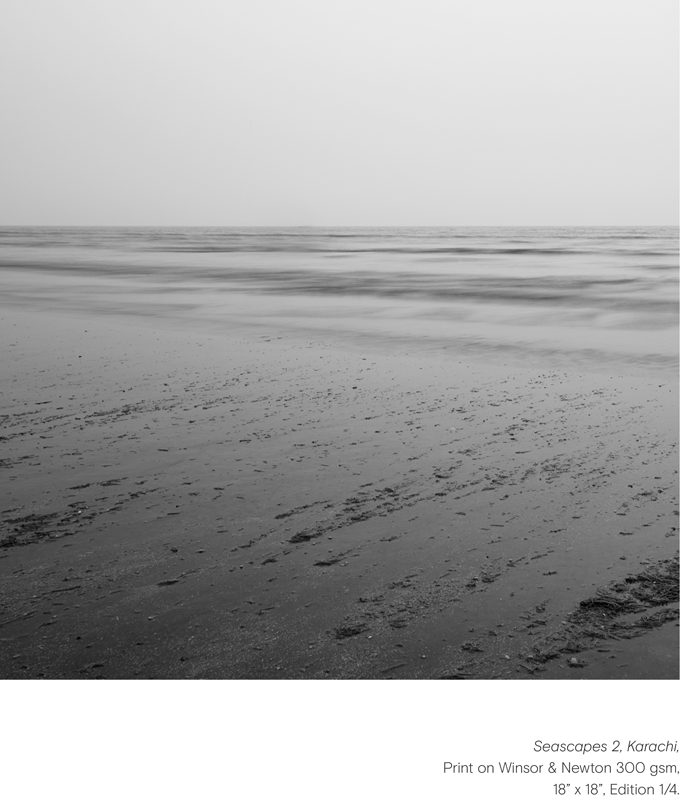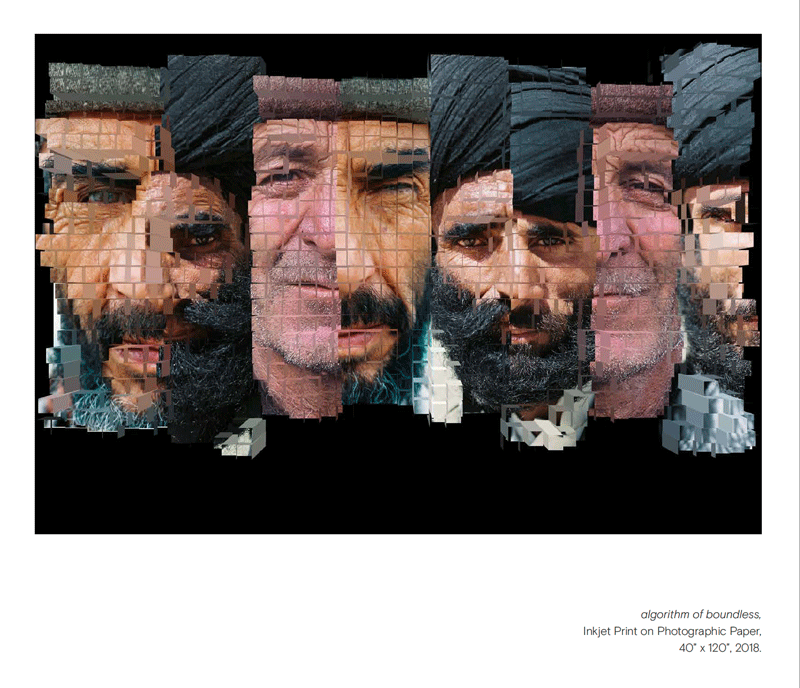Review: Photography Show
By Nusrat Khawaja | Art Line | Published 7 years ago

Tehmina Ahmed is a writer, filmmaker and photographer with wide experience in the field of visual media. She is a Senior Editor at Newsline Magazine and head of Newsline Films. She recently curated an exhibition of photographs at Koel Gallery. Tehmina selected six photographers (Amean J, Irfan Naqi, Madiha Aijaz, Mehreen Lali Khalid, Momin Zafar and Umar Riaz), whose trajectories she has been following for some time. They were asked to present their pictorial response to the title Boundaries…Boundless.
The curatorial brief assured: “The artist’s vision pushes against the boundary, to go towards the boundless.” As boundaries can be conceived in innumerable ways, this brief allowed the photographers immense latitude in its interpretation.
The theme of Amean J’s work was elemental, presenting just sky, sea and shore. His exploration concerned the “erratic intimacy between the land and the sea…” He presented five seascapes in mid-level grey monochrome. Each successive image decreased slightly in intensity. The short tonal range of greys rendered the textural differences between water and sand quite weakly. The crests of waves and the scatter of pebbles on the shore indicated subtle shifts of pattern between the sea and the land it embraces.
The sea also figured prominently but not exclusively in several of Madiha Aijaz’s photographs, within the 12-part series titled ‘In Two Languages.’ She presented the sea, a café, the roadside, as a theatre for human activities; group activity as in fishing, or recreation or solitude. Her work was about the patterns of activity generated by human engagement and the separation of cultural space. The characters in her images were shown unaware of the camera and preoccupied with their work. She used light and shadow to lend mystery to the day-to-day activities showcased in the work. The “futility and defeat within the layers of conventional belief systems” are of interest to her.
Mehreen Lali Khalid’s six works were studies of herself within various settings. In the clear light of day, she modelled as the subject of her own photography with the intent to “follow” herself to mark the moment she is situated in a particular place at a particular time. In each photograph, a scarf flutters around her like an aura, frozen in mid-air. This enigmatic detail introduced an element of magical realism in her photography.

Irfan Naqi is an architectural photographer and there is a monumental quality to his wall-sized entry. The ‘pictorial algorithm of boundless’ depicted four huge portraits which were bisected in half vertically to yield eight panels. The half portraits were paired with other mismatched halves. The entire construction – so to speak – was fragmented into brick-like segments comprising several hundred individual photographs. The overall impression given by this work was that of a pixelated assemblage. The photographer wanted to showcase “how the boundaries of photography in reality are actually just an optical illusion.”
Momin Zafar has created an interesting interplay of boundaries near and far. He had photographed the rain-specked window panes of the car from within the vehicle while driving in Gilgit-Baltistan. The rain drops held their unique shapes against surface tension and were in sharp focus. Beyond the window panes the mountainous landscape was visible as a misty, undulating blur. The elevated topography inspired him to muse philosophically: “How subtle the role of the spectator here, in situating and resituating the self…And how limited our lives on the plains seem.”
In his poem, Among School Children, W.B. Yeats wrote, “How can we know the dancer from the dance?” The visual counterpoint to Yeats’ metaphorical verse, was provided in Umar Riaz’s study of Nahid Siddiqui performing the Kathak. He wanted to explore the themes of boundaries and boundlessness within the very specific study of this dance form. In a series of 13 photographs, Umar Riaz began with a still, sharp portrait of Nahid Siddiqui poised to begin her dance. The twelve consecutive images were a lyrical study of a dancer in movement. Riaz worked with light and slow shutter speed to achieve images of stunning beauty. He did not use digital post-production effects. His images effectively show the inseparability of the dancer from the dance.
The six photographers negotiated various boundaries within the physical framework/boundary of the printed image. Amean J’s indeterminate demarcation between sea and shore; Madiha Aijaz’s boundaries between cultural and gender space; Mehreen Lali Khalid’s exploration of self and location; Irfan Naqi’s deconstruction of facial unity and identity; Momin Zafar’s investigation into visual perception of near and far; Umar Riaz’s unification of dancer with dance. The viewers were able to enter the boundaries of their visual imagination which contained the seeds for boundless dialogue.


